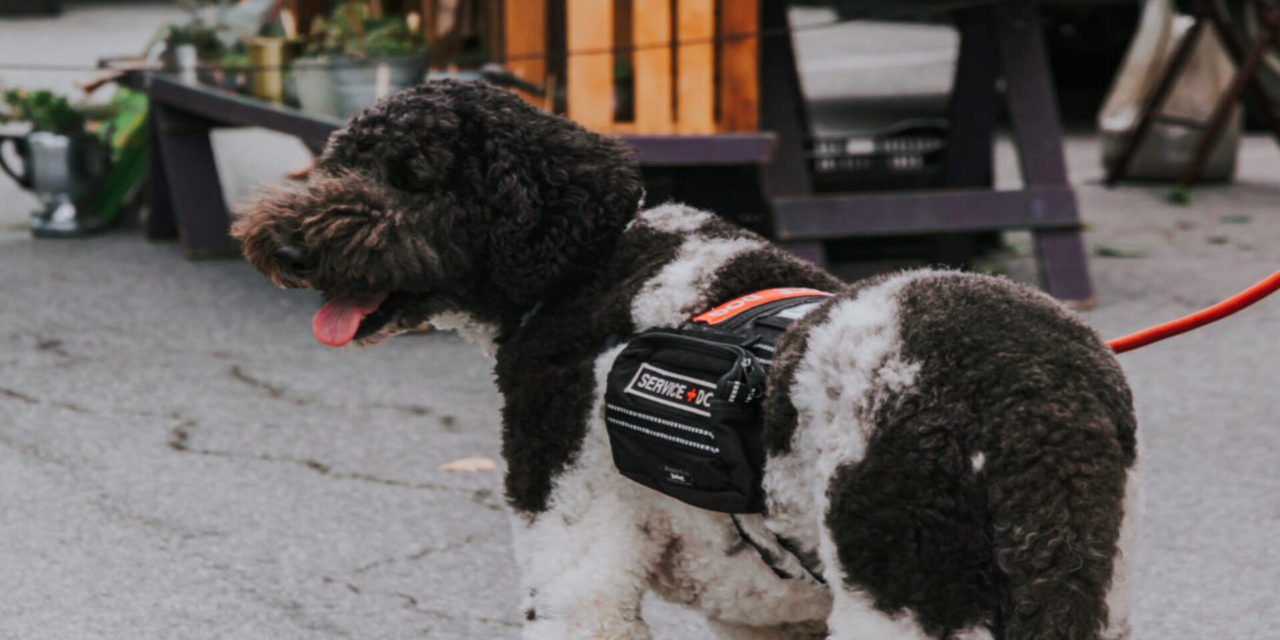Bucket Hats: Discover the Latest Trendy Designs
Bucket Hats: Discover the Latest Trendy Designs Bucket hats have become increasingly popular in recent years as a trendy accessory. These stylish hats are not


If you notice yourself feeling more upbeat and relaxed after a cuddle session with your comfort animal then you’ve experienced the wonders of owning a pet. In times like these, when we’re isolated due to the COVID-19 pandemic, many people are latching onto their pets or adopting one because the little critters make life more manageable.
Let’s dive into why that is, explore the different kinds of comfort animals, and see how you can improve your life by bringing a non-human friend into your home.

It’s been scientifically proven that all kinds of pets provide comfort, ease loneliness, improve physical activity, calm anxiety, and generally help with human’s mental, emotional, and physical well-being. Studies show that when we interact with animals, our cortisol levels (a stress-related hormone) decrease. It’s no wonder that college campuses bring in dogs or horses during finals season to de-stress college students. This also makes sense when you consider other facts like how people with pets have lower blood pressure in stressful situations than people without pets.
Along with the emotional benefits of owning a pet, pets improve our physical health too. For example, pet owners who are over sixty-five years old have 30% fewer doctor visits than those without pets. That’s because the effects of stress on the body can be significantly eased by being close to a comfort animal. For example, when people with borderline hypertension adopted dogs from a shelter, their blood pressure significantly declined after just five months.

Animals fulfill our basic need for touch, which is crucial in times like today when we’re social distancing and interacting virtually. The simple act of petting, hugging or cuddling up to a bunny, cat, dog, or another comfort animal can rapidly soothe humans. Having a pet also comes with responsibility. This can help one cope with daily life because you have to care for a living being besides yourself. They’re a reason to get out of bed in the morning because they can’t eat unless you feed them. This sense of meaning can do wonders for those suffering from depression, seasonal affective disorder, or other mental illnesses caused by internal and external factors.
Although this aspect doesn’t pertain to all comfort animals, owning a pet can increase your physical activity levels. This mostly applies to dogs and horses because you can take them on daily walks or rides and play with them. Also, taking your dog down the street is a great reason to leave the house in a COVID-19 safe way. You’ll get fresh air, sunshine, and some light cardiovascular activity while they enjoy their daily exercise. It’s a win-win situation!

Those who are autistic, have epilepsy, deaf, blind, or otherwise have a disability can significantly benefit from living with a pet or even visiting one. A qualitative research study looked at the behavioral and cognitive effects of dogs on groups of kids who have ADHD. They conducted the study by separating kids with ADHD into two groups. One group spent thirty minutes a week for twelve weeks, reading to a therapy dog. The other group spent the same thirty minutes for twelve weeks reading out loud but to a stuffed animal dog. After the twelve weeks, researchers noted that the first group had improved social skills, cooperation, and volunteering with fewer behavioral issues compared to the second group.
There are other obvious examples when pets help those with disabilities such as service dogs who guide people that are blind. A service dog can also detect seizures for those who suffer from epilepsy, pull wheelchairs, and detect dangerous allergens. That’s because they are trained to serve people with conditions or disabilities that are life-threatening. So in many ways, animals don’t just comfort us, they save us.
When it comes to pets, many labels can be thrown around. However, it’s important to recognize the difference between each “type” of comfort animal so you know how to interact with them in public spaces. Plus, if you need additional help, it’s great to know what pet classification is best for your needs.

This applies strictly to dogs and occasionally miniature horses because they can help someone navigate day-to-day life. Service dogs are highly trained to assist a single person’s individual needs. They often wear vests or harnesses as identifiers. If you see them in public spaces, you should not interact with them unless allowed because they’re literally on the job! Common breeds for service dogs:
Service dogs are trained by organizations, such as Michigan’s Paws for Cause, to serve people with disabilities.
Fun fact: In certain cases, Capuchin monkeys can work as service animals for those who are paralyzed or otherwise have limited mobility. They can be trained to turn on lights and pick up dropped items!

A pet that plays a key role in a patient’s mental and emotional treatment. They are either approved or suggested by a mental health professional. They are not specifically trained and do not typically wear a vest or harness. Examples of ESA or comfort animals include:

This title can apply to any type of animal that has a calm and gentle disposition that they share with many people, not just the owner. Unlike a service dog, strangers are encouraged to play with therapy dogs. They often visit nursing homes, hospitals, and other medical facilities because they provide therapeutic relief to those around them. Types of therapy comfort animals include:
In certain cities, you can find animal-assisted therapy if you can’t commit to taking in a pet. For example, in Kalamazoo, MI the Adult Agricultural Community Option for Residental Needs has a farm that offers therapeutic animal interactions for people with developmental disabilities.

If you’re sitting there and considering adopting a pet to become a service dog or emotional support animal, here’s what you need to know.
If you suffer from mental illnesses or psychotic disorders like PTSD, are a veteran, have autism or Asperger’s, or are otherwise recommended an ESA, you should be relieved to know they’re pretty easy to find and then register.
The first step to getting an ESA is adopting a comfort animal that you click with and meets your criteria. For example, if you live in a tiny studio apartment, getting a big Pitbull as an ESA doesn’t make as much sense as getting a smaller pet such as a cat, fish, or snake.
If you are struggling to find a dog pound, pet adoption center, or animal rescue near you, check out Petfinder.com. This website is great because after you answer a few questions and set up a profile, they will match you to nearby dogs, cats, rabbits, small & furry animals, scales & fins, birds, horses, and barnyard animals that are up for adoption. They have profiles for each animal too! They’re basically one big database with a bounty of resources on how to find shelter or rescue groups, how to foster a pet, and other animal FAQs.
Once you have adopted your ESA/comfort animal and fully latched onto each other, you can then use the ESA Registry to officially title your pet as an emotional support animal. Simply go online to www.esaregistration.org and register your pet for free. You can purchase vests, certificates, guidebooks, and therapy letters. This process can make it much easier for you to travel with your ESA. However, as of January 2020, ESAs are no longer considered a protected class of animal by U.S. airlines, which means airlines may disallow ESAs from traveling on commercial flights, or they might require a fee. That being said, airlines that do allow ESAs require an ESA prescription letter from a mental health professional for travel.
Another important fact about comfort animals, or ESAs, is that federal law doesn’t require them to wear clothing or harnesses identifying them as such. However, they are encouraged for handlers because they can save time and frustration over-explaining your animal’s presence.
Like we’ve previously mentioned, there is a stark difference between the purpose of an ESA and a service dog. Instead of simply adopting any kind of pet, one has to acquire a service dog from a reputable trainer or non-profit. Otherwise, you can adopt a dog and then bring it to a trainer to learn service work. Because of the nature of the situation, it’s most likely that someone will follow the former.

The Americans with Disabilities Act, which publishes regulations concerning service animals, does not require that service dogs wear a vest or display identification. The ADA also clarifies the difference between psychiatric service dogs and emotional support animals. Psychiatric service dogs assist individuals with disabilities such as obsessive-compulsive disorder, post-traumatic stress disorder, schizophrenia, and other conditions by turning on or off lights to mitigate stress, interrupting repetitive behaviors, and reminding a person to take their medication.
This distinction is further clarified by the U.S. Department of Justice, Civil Rights Division, Disability Rights Section by saying, “If the dog has been trained to sense that an anxiety attack is about to happen and take a specific action to help avoid the attack or lessen its impact, that would qualify as a service animal. However, if the dog’s mere presence provides comfort, that would not be considered a service animal under the ADA.”

Comfort animals are fantastic for reducing stress. There are so many activities you can do with comfort animals, especially dogs. Dogs are very good at learning different tricks. You can either manually teach them tricks, or dive into the world of technology and see how things like an embedded computer can teach dogs new tricks.
If you are planning on getting a comfort animal, make sure you buy all the appropriate things so that your animal is happy. If you need a start on spots to look at, check out Might Paw. They have really cool pet supplies and are a very helpful company.
These animals can often be nicer to you than humans. Hopefully, the next time your comfort animal gets close to you when you’re sad, you’ll start to smile because you’ve got someone rooting for you.
Bucket Hats: Discover the Latest Trendy Designs Bucket hats have become increasingly popular in recent years as a trendy accessory. These stylish hats are not

The ultimate guide to rocking the trendy bucket hat styles. Elevate your fashion game with versatile and stylish bucket hats. Click here for fashion inspiration and tips!
Discover the best places to buy bandanas and find your unique bandana style. Explore the wide range of designs and styles available at Wholesaleforeveryone.com and get free shipping on orders over $35
Discover how to create a stylish and versatile wardrobe with tops. Elevate your outfits and transform your style with the right tops. Click here to learn more.
Discover expert tips for caring and maintaining your tops to build a versatile wardrobe. Extend their lifespan, retain shape and color, and save money with proper care. Click now for a wardrobe that truly represents you
Fashion events for tops, including t-shirts, shirts, hoodies, and jackets, showcase the latest trends and styles. Stay updated with industry developments and explore Wholesaleforeveryone.com’s collection for quality